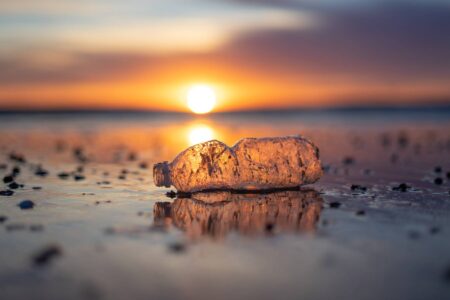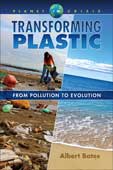I am addicted to plastic. How can I freak out about dolphins drowning in plastic nets or seagulls eating lighters and condoms off the beach, when I give no second thought to picking up a plastic comb in an airport shop, even if I decline the plastic bag?
The word “plastic” comes from the Greek verb plassein, which means “to mold or shape.” Its flexibility derives from long, bouncy chains of carbon, oxygen, and hydrogen atoms arrayed in repeating patterns that behave like a snake’s skin.
Snakeskin is a good example because biology has been knitting these molecular daisy chains for hundreds of millions of years. The cellulose that makes up the cell walls in reptiles is a polymer. Before there were plastic Wellies and galoshes, there were snakeskin boots.
“Polymer” is Greek for “many parts”; any polymer is a long chain of nearly identical molecules. The proteins that code the stems and flowers of daisies and also code our muscles, skin, and bones and the long spiraling ladders of DNA that entwine the genetic destinies of daisies and bones are all polymers. Take some of these protein chains, rearrange them slightly, and their choreography or dancers will dictate specific characteristics, just as different dance arrangements do.
Take just a moment and let’s walk back a step. The dancing line of carbon, oxygen, nitrogen, and hydrogen was no more than air and water, rearranged. But now we throw in chlorine and fluorine and what happens? Permanence. That substance has withdrawn from the contract with nature whereby all things must return full cycle, each with its own sunset clause.
The first artificial plastics — celluloid combs developed in 1869 by a young inventor in upstate New York — arrived at a moment of cultural transition. The turn of the twentieth century marked the birth of the consumer culture, the global switch from growing and preparing our own food and making our own clothing (excluding the aristocracy) to consuming mass market simulacra from factories. As historian Jeffrey Meikle pointed out in American Plastic: “By replacing materials that were hard to find or expensive to process, celluloid democratized a host of goods for an expanding consumption-oriented middle class.” Or as Susan Freinkel put it, plastics “offered a means for Americans to buy their way into new stations in life.”
They also offered a way for bacteria to shirk their stations in life.
Unintended Consequences
Celluloid combs and cellophane tape were gateway drugs. In 1907, Leo Baekeland combined cancerous formaldehyde with phenol derived from foul-smelling and nasty coal tar, and voila! His Bakelite was a tough, slick polymer that could be precisely molded and machined into nearly anything.

Families gathered around Bakelite radios to listen to programs sponsored by the Bakelite Corporation, drove Bakelite-accessorized cars, kept in touch with Bakelite phones, washed clothes in machines with Bakelite blades, pressed out wrinkles with Bakelite-encased irons — and, of course, styled their hair with Bakelite combs.
Bakelite inspired companies such as DuPont, Dow, Standard Oil, Union Carbide, and 3M to get into the race. Discoveries followed, and mass production of plastic products commenced. But Bakelite introduced something new to nature that was largely unappreciated at the time.
Once those molecules were linked into a daisy chain, they couldn’t be unlinked. Microbes don’t care to spend the energy required to break those tough bonds if they can find food more obliging elsewhere.
You can break a piece of Bakelite, but you can’t make it into something else. It does not degrade. It never goes away. This is why you’ll still find vintage Bakelite phones, frames, radios, and combs that look nearly brand new, and why today plastic debris is piling up on land and in the open ocean, in the entrails of dead whales on shorelines, and in living crustaceans on the deepest seabed of the Marianas Trench.

In nature nothing is permanent. Everything is food for someone else. Composers and decomposers coevolved in an endless dance — a harmony and rhythm that defines life. There is birth, and there is death. But we could not accept that.
In the last half century, there have been many drastic changes to the surface of our planet, but one of the most astonishing is the ubiquity and abundance of plastic. Even if we go extinct, that plastic will persist. We have only slowly moved from thinking of this as an aesthetic problem –litter and flotsam — to grokking that the choking wildlife we are seeing is actually a threat to us. Dead reefs and red tides are sending warnings: destroy the marine food chain and you’ll choke your own.
When consumers first considered the permanence of plastic, we thought it was a good thing. Bakelite replaced rhino horn, elephant tusk, and tortoiseshell but was even better — cheaper, tougher, wildlife-hunter safe. Remember: All of those flesh and bone things break down over time and need to be replaced. We were running out of rhinos, elephants, and tortoises.
In 1955, Life magazine ran the headline “Throwaway Living” below a photograph showing a family flinging plates, cups, and cutlery into the air. The items would take forty hours to clean, Life said, “except that no housewife need bother.” What Life failed to mention is that all those “disposable” items would still be around forty years later, and four hundred, and four million.

Cups, nylon stockings, radios, and telephones led to the “consumer culture” — a democratization of material comfort and leisure by making more things affordable to the masses through the clever vehicle of externalizing the true costs. The translation of plastics from camera film and nylons to the beverage and food-packaging industry further evolved the nascent consumer culture into a “throwaway culture.”
This new way of “using once and throwing away” metamorphosed into a normal feature of ordinary everyday lives, a practice that is not merely taken for granted but also nearly impossible to avoid. Forty per-cent of the 450 million tons of plastic produced each year is designed to be discarded after a single use, usually within minutes of purchase. Consider the 1,200 billion plastic bottles Coca-Cola produces each year or the plastic wrappers on your “garden-fresh” produce. What about Huggies, toothbrushes, or birth control packets?
More from Transforming Plastic:
Bypass plastics by shopping for reusable products in our online store:
- Bee’s Wrap Sustainable Food Storage
- Bamboo drinking straws
- Mother Earth News stainless steel drinking straws
- Bamboo Natural Home products
Reprinted with permission from Transforming Plastic: From Pollution to Evolution by Albert Bates and published by GroundSwell Books, 2019.





